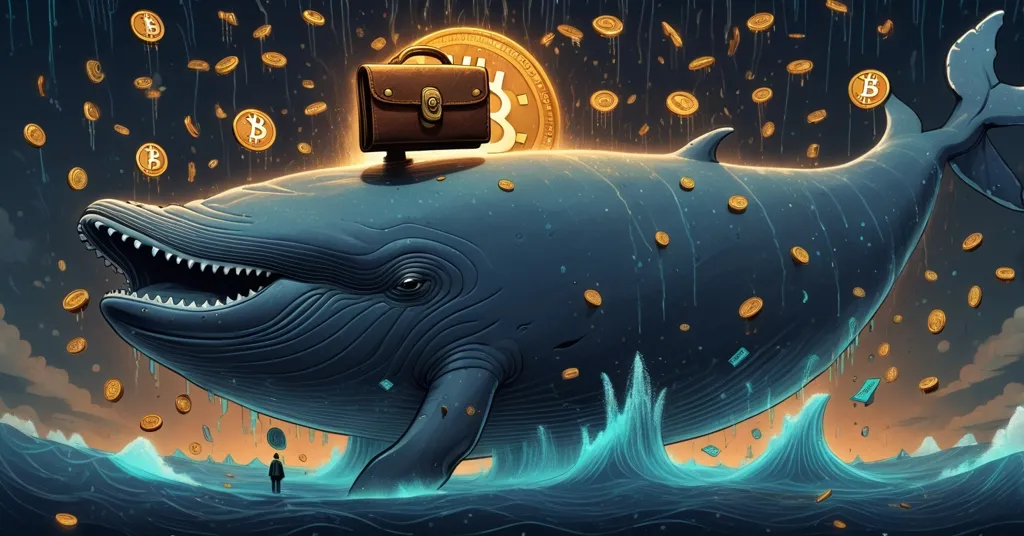Bitcoin Whale Awakens After 14 Years, Moves $16.6M from $440M Wallet—Market Impact Ahead?

Ancient Bitcoin Whale Awakens After 14.3 Years, Moves $16.6M from Dormant Wallet—What’s Next?
A Bitcoin whale has just resurfaced after 14.3 years of silence, transferring 150 BTC valued at $16.6 million from a wallet now worth over $440 million. What was once a modest $67,724 stash in 2011 has ballooned with a staggering 650,000% gain, proving once again why Bitcoin is the ultimate long-term play in the financial world. But what’s behind this sudden move, and could it signal broader shifts in the market?
- Massive Gains: A 4,000 BTC wallet, dormant since 2011, now worth $440M, moved 150 BTC ($16.6M).
- Historical Context: Coins mined when block rewards were 50 BTC, compared to 3.125 BTC today after four Halvings.
- 2025 Trend: Record 270,000 BTC (dormant 7+ years) already moved this year, with more expected.
Why Bitcoin Whales Matter in the Ecosystem
Bitcoin whales—those holding massive stashes of BTC—can influence markets and sentiment with a single transaction. Their moves often spark speculation about price trends, profit-taking, or even lost fortunes resurfacing. This ancient whale’s awakening after nearly a decade and a half has the community on edge, and for good reason. Let’s unpack the details with the clarity and grit you expect from us.
The Whale’s Story: From Pennies to Millions
Thanks to public transaction records on the Bitcoin blockchain—often called on-chain data and tracked by services like Whale Alert—this wallet’s history is an open book. It likely belonged to an early miner who accumulated 4,000 BTC back in 2011, a time when mining a single block rewarded a hefty 50 BTC. That’s a stark contrast to today’s 3.125 BTC per block after four Halving events in 2012, 2016, 2020, and 2024. For newcomers, a Bitcoin Halving cuts the mining reward roughly every four years, slowing the creation of new coins to enhance scarcity and, ideally, drive up value. Back then, it took just 80 blocks to amass this fortune. Today, you’d need over 1,200 blocks, facing fierce competition and electricity costs that could bankrupt a small town.
In 2011, Bitcoin was a fringe idea, traded for cents among a tiny community of a few thousand cypherpunks and tech enthusiasts. There were no major exchanges, and early adopters often spent BTC on trivial things—think 10,000 BTC for two pizzas in 2010, a transaction now worth over a billion dollars. Fast forward to 2025, with Bitcoin trading at $111,100 per TradingView data, and this whale’s holdings could buy a fleet of luxury cars—or fund a personal financial revolution. The recent transfer of 150 BTC, executed for a remarkably low fee of $0.22, raises eyebrows. Is this a test? A partial cash-out? Or a subtle flex of unshakable resolve? For more on this incredible story of an ancient Bitcoin whale resurfacing, the numbers speak for themselves.
Let’s speculate with grounded skepticism. Could the original miner have rediscovered their private keys after forgetting them for over a decade? Or did a third party exploit outdated security in 2011-era wallet software—think of it as cracking a safe with a rusted lock, easy pickings for modern hackers? Early Bitcoin wallets often lacked today’s safeguards like multi-signature features or robust encryption, leaving them vulnerable to brute-force attacks, phishing, or keyloggers that early users underestimated. Then there’s the unlikely romantic notion of a true HODLer—someone who holds onto Bitcoin through thick and thin, ignoring every market crash and scare tactic (known as FUD, or Fear, Uncertainty, Doubt)—finally moving a fraction now. Frankly, most wallets this old stay dormant because they’re lost—keys misplaced, owners passed away, or hard drives tossed in a landfill somewhere. Just ask James Howells, still searching for a $500 million Bitcoin fortune buried in Welsh trash.
2025’s Dormant Bitcoin Surge: A Growing Trend
While this whale’s motives remain a mystery, their actions fit into a larger wave of ancient Bitcoin stirring to life. CryptoQuant analysts note that 2025 is shattering records for the movement of old coins—those untouched for over seven years. So far, 270,000 BTC have shifted hands, outpacing all of 2024 with two months to spare. We could hit 300,000 BTC by December.
“In 2025, Bitcoin movements of coins dormant for 7+ years have already exceeded 2024 levels, and there are still two months left.” – CryptoQuant analyst
What’s fueling this surge in dormant Bitcoin wallet activity? Bitcoin’s climb to $111,100 might be tempting long-term holders to lock in profits. Alternatively, advancements in wallet recovery tech could be resurrecting forgotten stashes from digital graves. Some of these coins are heading to exchanges for sale, others to cold storage for safekeeping, and a few even to DeFi protocols chasing yield, though exact breakdowns vary across blockchain analytics like Glassnode. Regardless, it’s a sharp reminder of Bitcoin’s dual identity: a time capsule of wealth for early believers and a potential market shaker if too many giants cash out at once.
Market Implications: Bullish Signal or Bearish Warning?
Now, let’s flip the coin and scrutinize both sides. A 150 BTC sale is a speck of dust in the grand scheme—Bitcoin’s daily trading volume often exceeds $30 billion. Even if this whale unloads their entire 4,000 BTC, valued at $440 million, the market could likely absorb it. Institutional players like BlackRock’s IBIT and Fidelity’s FBTC have amassed over 500,000 BTC combined through spot ETFs, providing a buffer against sudden sell-offs. But here’s the catch: if 2025’s trend of old Bitcoin movement accelerates, and more ancient whales start dumping, we could see real downward pressure. History offers a cautionary tale—during the 2018 bear market, large sales from early adopters fueled price slides, amplifying panic. Compare this to other whale events, like the 2019 movement of 94,000 BTC tied to the PlusToken scam, which rattled markets for weeks.
On the brighter side, these moves might signal confidence. Early adopters could believe the market is mature enough to handle sales without collapsing. Stories of 650,000% gains also serve as powerful PR, reminding newcomers that Bitcoin isn’t just a speculative bubble—it’s a proven store of value for those with patience. Yet, let’s not get carried away. While wallet recovery firms are helping some reclaim lost BTC, the harsh reality is most early coins are gone forever. Forget the fantasy of uncovering a forgotten Bitcoin goldmine—it’s a brutal truth that separates dreamers from the decentralized vision we champion.
Bitcoin’s True Promise: Beyond the Windfalls
Here at Let’s Talk, Bitcoin, we’re passionate about decentralization, privacy, and disrupting the outdated financial system. This whale’s journey—from an anonymous miner in 2011 to a potential multi-millionaire in 2025—embodies that ethos. Bitcoin empowered someone to create wealth outside the grip of banks and governments, no questions asked. But let’s cut through the hype with a dose of reality. Bitcoin’s future isn’t about lottery-style windfalls for a lucky few. It’s about crafting a censorship-resistant, borderless money system that no suit in a corner office can control. That said, a 650,000% return? That’s the kind of effective accelerationism—full-throttle disruption through tech—that gets our blood pumping.
Looking ahead, there are factors to watch. If whale sales trigger volatility, regulators might take notice, tightening scrutiny on crypto markets. Conversely, spot ETFs could continue soaking up selling pressure, stabilizing prices. Imagine stumbling across an old laptop from 2011 with a forgotten Bitcoin wallet worth millions—would you sell now, or hold for another decade? More critically, will these ancient whales propel Bitcoin to new heights, or test the limits of its price stability?
Key Questions and Takeaways on Bitcoin Whale Activity
- What triggered the reactivation of a 14.3-year-old dormant Bitcoin wallet?
Possible reasons include the original owner rediscovering their keys, a third party exploiting outdated security, or a long-term holder moving funds, potentially spurred by Bitcoin’s price of $111,100. - How significant is a 150 BTC transfer in today’s market?
It’s minor—$16.6 million pales against Bitcoin’s daily trading volume of over $30 billion. Even the full 4,000 BTC at $440 million wouldn’t shake current liquidity much. - Why are so many old Bitcoin coins moving in 2025?
High prices like $111,100 and better recovery methods are likely drivers, with 270,000 BTC (dormant 7+ years) already moved, potentially reaching 300,000 by year-end per CryptoQuant data. - Does this whale’s move signal a broader sell-off risk?
Not yet—isolated sales are manageable, but a wave of ancient whales selling could pressure prices, as seen in past bear markets like 2018. It might also reflect market maturity. - What does this story say about Bitcoin’s value proposition?
It reinforces Bitcoin as a store of value with unreal gains (650,000% here) for early adopters, while showcasing its decentralized power to build wealth free from traditional gatekeepers.
This saga of an ancient Bitcoin whale resurfacing is a compelling chapter in the cryptocurrency narrative. It highlights the incredible rewards of holding through chaos, but also the stark reality that not every wallet has a fairy-tale ending. As we advocate for decentralization and financial freedom, we’re keeping a close eye on these old coins. In Bitcoin’s world, history doesn’t just repeat—it sometimes cashes out with a vengeance.



